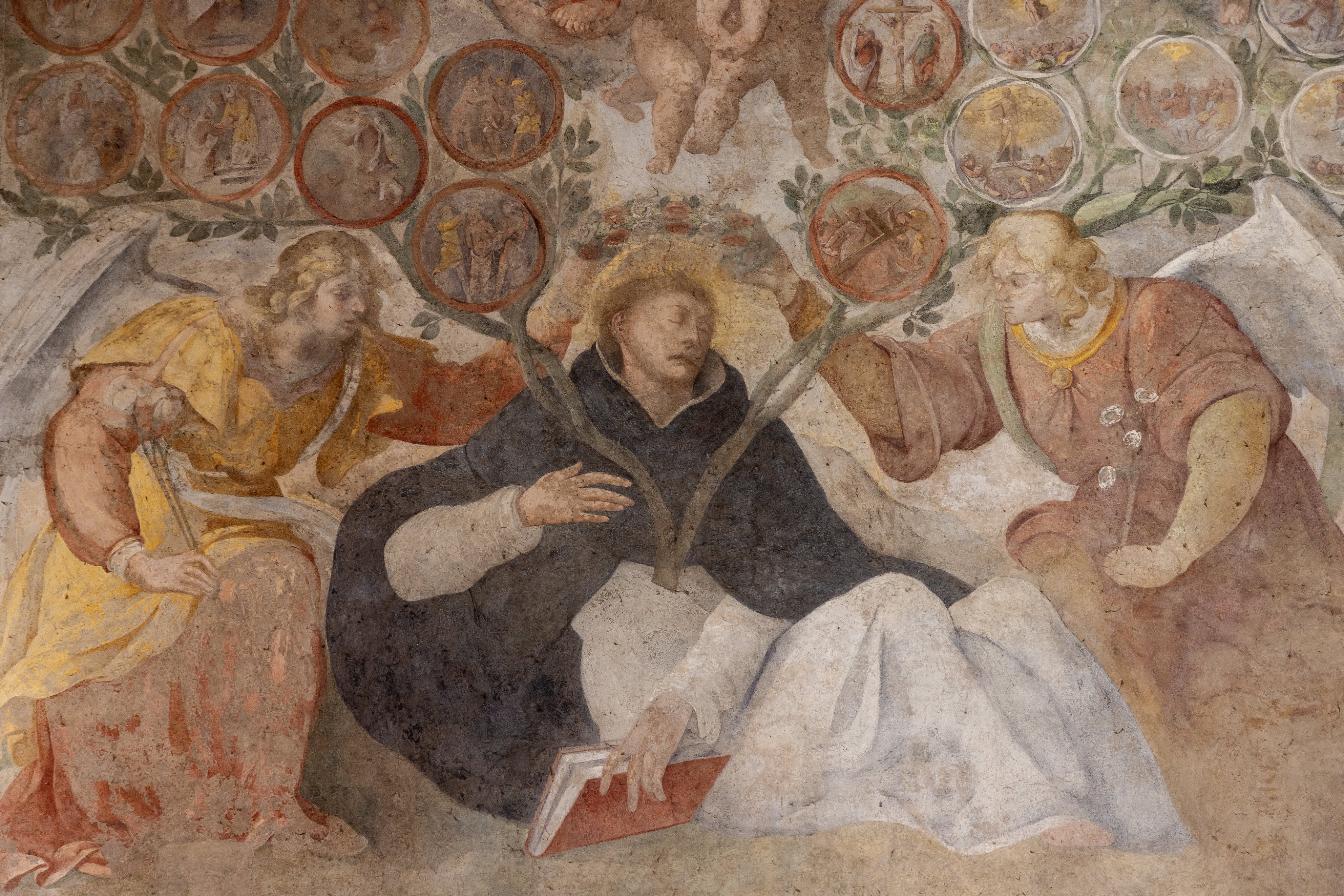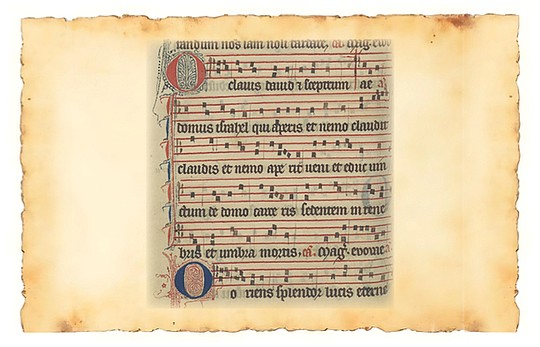Waiting to be discovered: Rome cloister's frescoes celebrate the rosary
August 21, 2024 at 2:42 p.m.

ROME CNS – Very much on the beaten path of tourists and pilgrims to Rome, a frescoed ode to the rosary is visited by as few as a dozen people a day.
PHOTO GALLERY- Cloister Santa Maria Sopra Minerva in Rome
The cloister of the Dominican friars at the Basilica of Santa Maria Sopra Minerva was built in the mid-1500s, and the frescoes are believed to be from the early 1600s, but it is the church next door that draws the visitors.
Hundreds of people go in and out of the basilica each day for Mass or confession or to pray at the tomb of St. Catherine of Siena. They go to see Michelangelo's statue of the risen Christ and Filippino Lippi's frescoed chapel in honor of St. Thomas Aquinas. At the very least, on their way to the Pantheon nearby, they stop outside to see the elephant statue designed by Gian Lorenzo Bernini.
 A tree growing from St. Dominic with the 15 joyful, sorrowful and glorious mysteries of the rosary are seen in a fresco in the cloister of the Dominican friars' convent next to the Basilica of Santa Maria Sopra Minerva in Rome Aug. 21, 2024. The friars have opened the cloister to visitors, although few tourists and pilgrims know it exists. (CNS photo/Pablo Esparza)
A tree growing from St. Dominic with the 15 joyful, sorrowful and glorious mysteries of the rosary are seen in a fresco in the cloister of the Dominican friars' convent next to the Basilica of Santa Maria Sopra Minerva in Rome Aug. 21, 2024. The friars have opened the cloister to visitors, although few tourists and pilgrims know it exists. (CNS photo/Pablo Esparza)Pablo Esparza
But they miss the door to the left of the basilica leading to the highly decorated cloister, which is a covered walkway surrounding a garden that boasts: a fountain; fruit trees, including one with peaches ripening in the sun; baskets of petunias; a pair of olive trees; oleander and geranium bushes; a blooming hibiscus; and two palm trees towering over the five-story convent and offices.
The first fresco visitors see upon entering the cloister is a large depiction of St. Dominic with Our Lady of the Rosary and "the tree of the 15 mysteries of the rosary." Dominican Father Daniel Als said members of the Confraternity of the Holy Rosary paid for the frescoes at the beginning of the 17th century, and so instead of the traditional symbolism of a holy founder at the base of a "family tree" depicting the other orders his charism inspired, the cloister fresco depicts the mysteries of the rosary as the branches of a tree growing out of St. Dominic.
The paintings reflect a pious tradition that says Mary appeared to St. Dominic in 1214 and gave him the rosary, asking him to teach it to others as part of the battle against heresy.
Farther into the cloister, the joyful, sorrowful and glorious mysteries of the rosary are each given their own lunette or panel with the Annunciation leading the way. Another series of frescoes illustrate scenes from the life of St. Thomas Aquinas,
Father Als, one of the 20 friars who lives in the international community at the convent, said an average of 10 to 20 visitors enter each day with numbers increasing a bit on Saturdays. The friars opened the cloister to the public a year ago, but Rome newspapers still refer to it as a "hidden" gem.
Sitting in the porter's lodge on a bright August morning, Father Als buzzes visitors in, and he wishes them a good day as they leave. He doesn't say anything about the little metal box on the counter, though some visitors seem to know instinctively that it is a place for donations.
Sometimes there are more cats in the cloister than pilgrims. Three cat carriers – minus their doors – sit in the northeast corner of the cloister next to bowls of water and food. But on the morning of Aug. 20, the cats are in the southeast corner, sleeping on the green cushions of the chairs the friars use when taking a bit of cool air in the evening.
The Church needs quality Catholic journalism now more than ever. Please consider supporting this work by signing up for a SUBSCRIPTION (click HERE) or making a DONATION to The Monitor (click HERE). Thank you for your support.
Related Stories
Sunday, December 14, 2025
E-Editions
Events
ROME CNS – Very much on the beaten path of tourists and pilgrims to Rome, a frescoed ode to the rosary is visited by as few as a dozen people a day.
PHOTO GALLERY- Cloister Santa Maria Sopra Minerva in Rome
The cloister of the Dominican friars at the Basilica of Santa Maria Sopra Minerva was built in the mid-1500s, and the frescoes are believed to be from the early 1600s, but it is the church next door that draws the visitors.
Hundreds of people go in and out of the basilica each day for Mass or confession or to pray at the tomb of St. Catherine of Siena. They go to see Michelangelo's statue of the risen Christ and Filippino Lippi's frescoed chapel in honor of St. Thomas Aquinas. At the very least, on their way to the Pantheon nearby, they stop outside to see the elephant statue designed by Gian Lorenzo Bernini.
 A tree growing from St. Dominic with the 15 joyful, sorrowful and glorious mysteries of the rosary are seen in a fresco in the cloister of the Dominican friars' convent next to the Basilica of Santa Maria Sopra Minerva in Rome Aug. 21, 2024. The friars have opened the cloister to visitors, although few tourists and pilgrims know it exists. (CNS photo/Pablo Esparza)
A tree growing from St. Dominic with the 15 joyful, sorrowful and glorious mysteries of the rosary are seen in a fresco in the cloister of the Dominican friars' convent next to the Basilica of Santa Maria Sopra Minerva in Rome Aug. 21, 2024. The friars have opened the cloister to visitors, although few tourists and pilgrims know it exists. (CNS photo/Pablo Esparza)Pablo Esparza
But they miss the door to the left of the basilica leading to the highly decorated cloister, which is a covered walkway surrounding a garden that boasts: a fountain; fruit trees, including one with peaches ripening in the sun; baskets of petunias; a pair of olive trees; oleander and geranium bushes; a blooming hibiscus; and two palm trees towering over the five-story convent and offices.
The first fresco visitors see upon entering the cloister is a large depiction of St. Dominic with Our Lady of the Rosary and "the tree of the 15 mysteries of the rosary." Dominican Father Daniel Als said members of the Confraternity of the Holy Rosary paid for the frescoes at the beginning of the 17th century, and so instead of the traditional symbolism of a holy founder at the base of a "family tree" depicting the other orders his charism inspired, the cloister fresco depicts the mysteries of the rosary as the branches of a tree growing out of St. Dominic.
The paintings reflect a pious tradition that says Mary appeared to St. Dominic in 1214 and gave him the rosary, asking him to teach it to others as part of the battle against heresy.
Farther into the cloister, the joyful, sorrowful and glorious mysteries of the rosary are each given their own lunette or panel with the Annunciation leading the way. Another series of frescoes illustrate scenes from the life of St. Thomas Aquinas,
Father Als, one of the 20 friars who lives in the international community at the convent, said an average of 10 to 20 visitors enter each day with numbers increasing a bit on Saturdays. The friars opened the cloister to the public a year ago, but Rome newspapers still refer to it as a "hidden" gem.
Sitting in the porter's lodge on a bright August morning, Father Als buzzes visitors in, and he wishes them a good day as they leave. He doesn't say anything about the little metal box on the counter, though some visitors seem to know instinctively that it is a place for donations.
Sometimes there are more cats in the cloister than pilgrims. Three cat carriers – minus their doors – sit in the northeast corner of the cloister next to bowls of water and food. But on the morning of Aug. 20, the cats are in the southeast corner, sleeping on the green cushions of the chairs the friars use when taking a bit of cool air in the evening.
The Church needs quality Catholic journalism now more than ever. Please consider supporting this work by signing up for a SUBSCRIPTION (click HERE) or making a DONATION to The Monitor (click HERE). Thank you for your support.










